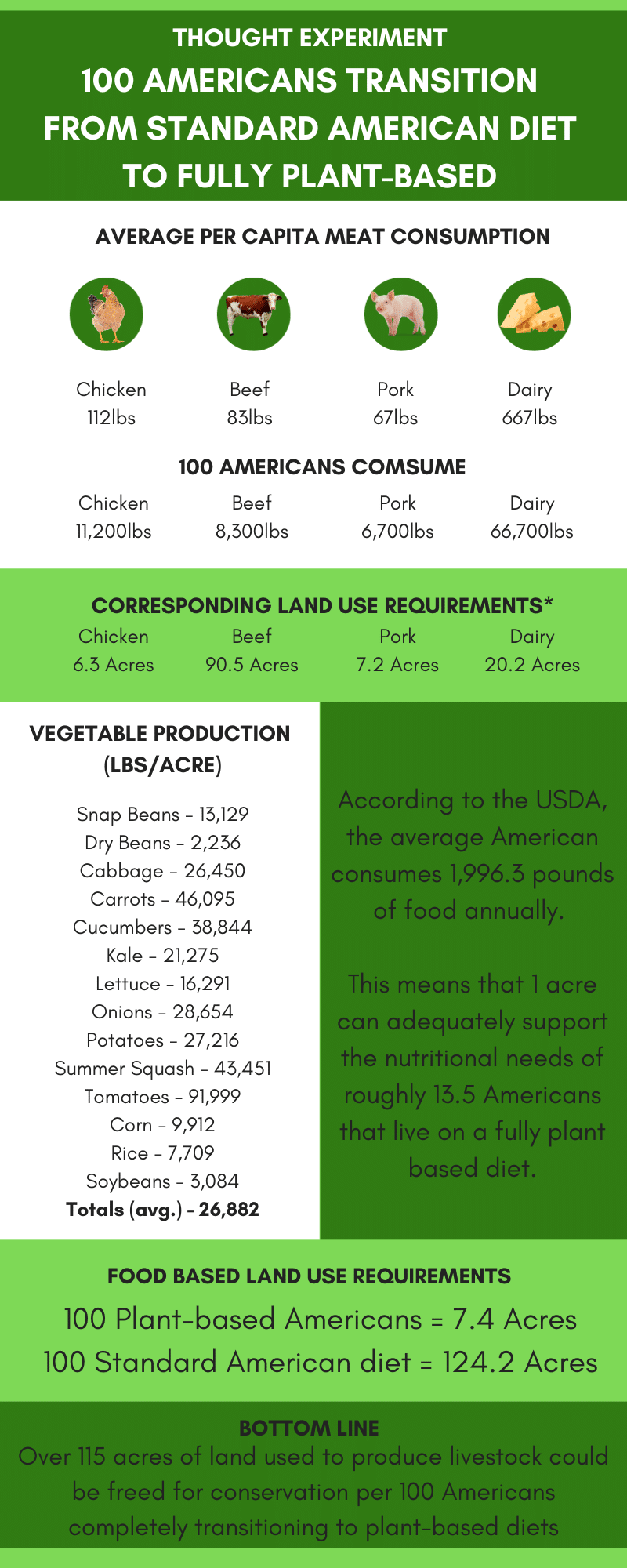

As a thought experiment, suppose that 100 people currently eating the standard American diet switch to a fully plant-based diet. We know this change would have an environmental impact, but how great would it be? Moreover, how can we best communicate the potential of such a transition to demonstrate how these decisions impact the environment?

While scientists have been actively debating how much livestock contributes to climate change and environmental degradation in terms of carbon dioxide equivalents, I have found that it is much easier to visualize and relate these topics to people in terms of land use requirements. Not only is it easier to comprehend, but people can feel the crisis more personally when land use inefficiencies are laid bare.
One of the most contentiously debated topics when accounting for human actions driving climate change is related to livestock production. The estimates vary wildly from as low as 11.1% to 51% of total emissions. This is a massive range: 6.19 billion metric tons versus 32,564 million tons of CO2 equivalent released annually. The differences come from simple and complex variations between how we count carbon dioxide equivalents, and the uncertainty leaves people feeling confused, which is perhaps the point.
But what is lost in communicating these issues in this way to the general public? How easy is it to visualize or compare 6.19 billion metric tons to 32,564 million metric tons? What are we supposed to do with this information, and how can we translate these numbers to the realities of climate change and environmental degradation? By communicating these critical topics in such an abstract way, can we fully grok the impacts we are having on the environment? Polls show that while most American adults believe in the realities of climate change, there is widespread confusion about the causes and consequences of human-driven climate change. While media portrayals of climate change undoubtedly have contributed to this confusion, there are signs that we are failing to communicate and educate on how we are impacting the climate through our actions and that new mental models will be needed to address common misconceptions regarding the causes and upcoming changes due to how we affect the environment.[1]
Rather than communicating the CO2 equivalents as if we can fully comprehend and appreciate what 32,564 million metric tons of CO2 can do to the environment, wouldn’t it help to have a more tangible way to communicate the environmental impacts of our food choices? If we could convey these critical issues in ways that better connect with people, would it lead to more substantial change?

By talking about the impact livestock has on the environment in terms of land use changes, we can better connect livestock production to a myriad of important topics. For example, we can see the inefficiencies in livestock production, reflected in the above thought experiment, in that livestock accounts for 77% of all agricultural land while only producing 18% of global calorie intake.[2] We can further extrapolate that these inefficiencies are leading to mass extinction on calamitous scales—with 90% of habitat lost, 50% of all animal species are expected to go extinct.[3] This means livestock production, being the single largest contributor to land use changes globally, has had an outsized impact on the biodiversity crisis, driving the sixth mass extinction. The United Nations acknowledges that our food system is the primary driver of biodiversity loss, with agriculture alone threatening 86% of species at risk of extinction, calling for more plant-based systems to reverse these changes.[4]
In thinking about these issues in terms of land use changes, we can also avoid common pitfalls arising from an emphasis on CO2 equivalents. For example, studies have shown that holistic grazing practices can reduce the CO2 emissions related to cattle production by up to 66%.[5] If thinking strictly about CO2, this would seem like the clear path to reducing our environmental footprint. Yet when we also consider the land use requirements, we discover that this “solution” has side effects. The same study showed that these holistic grazing systems required 2.5 times more land to be equally productive and would therefore drive habitat loss and mass extinction. Reduced carbon emissions should not come at the expense of habitat and biodiversity.
Agriculture is one of the most destructive forces humans have ever unleashed on the planet. It has led to runaway climate change, land use changes fueling the majority of deforestation and wetland loss worldwide, soil degradation, and the sixth mass extinction event of Earth’s history. Due to that catastrophic environmental impact, food-based solutions are some of the most influential for reversing climate change, habitat loss, and mass extinction. Plant-based food systems can feed the world’s growing populations while conserving the majority of land used for agriculture today, thereby reversing trends of mass extinction and environmental degradation. To communicate these topics in terms of “millions of metric tons of CO2 equivalents’” is not getting the job done. We must seek more relatable and understandable terms that the public can easily see and empathize with.
References for Infographic
Kuck, Gretchen, and Gary Schnitkey. 2021. “An Overview of Meat Consumption in the United States.” farmdoc daily. https://farmdocdaily.illinois.edu/2021/05/an-overview-of-meat-consumption-in-the-united-states.html.
Adams, Rachel. 2022. “USDA data shows Americans are eating more dairy than ever before.” Food Beverage Insider. https://www.foodbeverageinsider.com/dairy/dairy-consumption-hits-record-level-us.
Land use requirements are 91.69lbs./acre for beef, 927.47lbs/acre for pork, 1773.47lbs./acre for chickens, 3308.59lbs/acre for milk. Calculations are based on dressed weights. https://humaneherald.files.wordpress.com/2019/01/production-of-foods-per-acre.pdf
Videle, James. 2019. “Comparison of Farming in Production of Food Per Acre Measuring vegan-organic agriculture vs. animal-based agriculture.” The Humane Herald. https://humaneherald.files.wordpress.com/2019/01/production-of-foods-per-acre.pdf.
USDA. 2022. “Crop Production 2021 Summary.” Crop Production 2021 Summary 01/12/2022. https://downloads.usda.library.cornell.edu/usda-esmis/files/k3569432s/sn00c1252/g158cj98r/cropan22.pdf
Copyright 2025 Center for Nutrition Studies. All rights reserved.